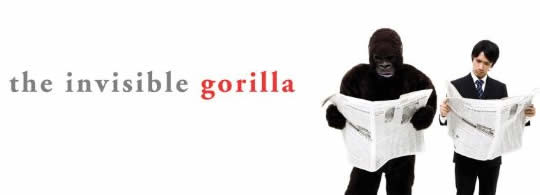The Invisible Gorilla
Review: The Invisible Gorilla: And Other Ways Our Intuitions Deceive Us, by Christopher Chabris and Daniel Simons
Before reading farther, watch this video if you haven’t already seen it:
The Invisible Gorilla provides an interesting counterpoint to Malcolm Gladwell’s Blink. While Gladwell sought to show that our minds can perform remarkable feats of judgment, often without conscious processing, Chabris and Simons show us how many ways our human brains can fail. If that sounds depressing, it’s not really. The Invisible Gorilla seeks to expose some of the limitations of our brains in areas like observation and memory; with this understanding, we can adopt strategies to compensate for them.
The book derives its name from a well known experiment conducted by the authors more than ten years ago. Subjects were shown a video (embedded below) in which teams passed a basketball back and forth, and were told to count the passes. Half of the subjects failed to notice a gorilla (actually, a student in a full gorilla suit) walked into the middle of the floor, thumped its chest, and wandered off. This research has long been cited as a prime example of the limits of human observation.
Chabris and Simons suggest that the “unexpected” nature of the gorilla accounts for its invisibility to so many participants. Had the subjects been told to watch for a gorilla, certainly almost all would have spotted the hairy creature amidst the basketball players. The authors extend this logic to explain other observational failures, notably the frequency with which automobile drivers seemingly tune out motorcycles which should be in their field of vision.
False memories are another key topic in the book. The player choking incident involving legendary basketball coach Bobby Knight, then at Indiana University, gets special attention. It’s an interesting anecdote, as the participants and observers went on the record with their recollections of what happened before a video of the incident surfaced. Nobody’s recollection matched the facts, from Knight’s denial that he grabbed the player to the player’s own dramatic embellishment of an extended altercation. Chabris and Simons suggest that these memory failures aren’t always self-serving falsehoods, but really are what people recall happening. They cite other examples, from Hillary Clinton’s tall tale about landing under fire in Bosnia to eyewitness testimony that convicts innocent people, as other examples of memories that have been stored or recalled inaccurately. They note that most people overestimate the accuracy of their own memories, and assume when someone else’s recollection is shown to be false that the individual was consciously lying.
Chabris and Simons take on Blink and the supposed power of intuitive decision making directly in several chapters. In his book, Gladwell recounts the story of a classic sculpture that had been examined extensively by scientists and proclaimed authentic, while an individual art expert thought something was wrong with the sculpture’s proportions after a cursory visual examination. The sculpture was indeed a forgery.
The Invisible Gorilla recounts the story of a forger of rare books who fooled dozens of expert collectors by selling them previously unknown early versions of famous works. These collectors, presumably, handled thousands of rare volumes and should have had a strong intuitive sense for the legitimacy of antiquarian books. It wasn’t until extensive scientific testing discovered that the paper the books were printed on didn’t match their supposed publication dates that the scam was exposed.
Of course, that’s the problem with anecdotes: one can find an anecdote to prove most anything, and often that anecdote is more persuasive than properly collected scientific data. The authors, though not averse to using anecdotes themselves, point out their ability to influence our thinking.
Chabris and Simons spend many pages examining the persistence of belief in the “Mozart Effect.” One small study showed that students who listened to Mozart before an intelligence test demonstrated a higher IQ than those who didn’t, and the concept spread like wildfire. Even though the original study was debunked by many later studies, millions of dollars of Mozart-based IQ-boosting products were sold. Surveys show that belief in the Mozart effect persists to this day.
Watch for a few neuromarketing takeaways from The Invisible Gorilla in the coming days.
Buy at Amazon: The Invisible Gorilla: And Other Ways Our Intuitions Deceive Us

